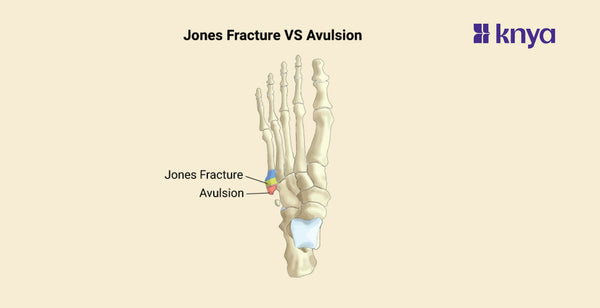Jones Fracture vs Avulsion: A Jones Fracture and an Avulsion fracture are both injuries of the foot or ankle, specifically the fifth metatarsal bone. A Jones Fracture especially happens at the base of the fifth metatarsal as a result of indirect stress or force, which frequently results from jogging or ankle twisting exercises. These fractures are considered severe because they have a higher risk of poor healing and nonunion, especially without proper treatment. In most cases, treatment consists of immobilisation with a walking boot or cast; in certain cases, particularly in sportsmen, surgery may be required. Conversely, in an Avulsion fracture, a tendon or ligament pulls a small fragment of bone away from the main bone. This kind of fracture is usually less severe than Jones Fractures and is usually brought on by abrupt muscular contractions or twisting motions. Although surgery may be required in certain circumstances, Avulsion fractures typically heal effectively with rest and conservative therapy. To summarise, both types of fractures impact the fifth metatarsal; however, Avulsion fractures often have a better prognosis with conservative management, while Jones Fractures are more serious and may require more aggressive treatment.
Difference between Jones Fracture and Avulsion
Avulsion fractures, which include the separation of the bone from a tendon or ligament pull, usually heal well with conservative methods, whereas Jones Fractures, which occur at the base of the fifth metatarsal, are frequently caused by indirect stress and require surgical intervention for good recovery. The table below provides the differences between Jones Fracture and Avulsion.
|
Aspect |
Jones Fracture |
Avulsion Fracture |
|
Location |
Base of the fifth metatarsal bone in the foot |
Typically involves a fragment pulled away from main bone |
|
Mechanism of Injury |
Indirect force or stress on the foot |
Sudden, forceful pull of a tendon or ligament |
|
Severity |
Considered more severe due to the higher risk of nonunion |
Generally less severe, with a better prognosis |
|
Treatment |
May require immobilisation and possibly surgery |
Often managed conservatively, surgery is less frequently needed |
|
Symptoms |
Pain, swelling, bruising, tenderness, difficulty walking |
Pain, swelling, tenderness, difficulty moving the affected area |
Browse The Best Scrubs Collection!
What is Jones Fracture?
A Jones Fracture is a form of fracture that occurs near the base of the fifth metatarsal bone of the foot. Indirect force or stress, like twisting the ankle, or repetitive stress from exercises like jogging or leaping, are the usual causes. Because they are more likely to result in poor healing and nonunion, Jones Fractures are regarded as more serious than other fractures in this region.
Causes of Jones Fracture
- Trauma: A Jones Fracture may result from direct trauma to the foot, such as a fall or a heavy item landed on the foot.
- Twisting Motion: Excessive tension on the fifth metatarsal bone can lead to a fracture when an ankle is twisted or rolled, particularly during sports like basketball or soccer.
- Repetitive Stress: Activities like running or jumping that put repetitive strain on the foot can progressively weaken the bone and increase the risk of fracture, especially in people with poor biomechanics or inappropriate footwear.
- Overuse: Overuse injuries, which are frequent among athletes participating in high-impact sports, can eventually lead to the development of Jones Fractures.
Symptoms of Jones Fracture
- Pain: Pain is frequently experienced close to the base of the fifth metatarsal bone on the outside side of the foot. Sharp pain that gets worse when you move or do weight-bearing activities may be experienced.
- Swelling: Following an injury, swelling is frequently observed in the vicinity of the fracture and may appear immediately or gradually over several days.
- Bruising: As a result of bleeding from the fracture site, there may be bruises or discolorations on the outside of the foot or ankle.
- Walking Difficulties: If the fracture is unstable or displaced, it may be uncomfortable or difficult to walk or bear weight on the affected foot.
- Tenderness to the Touch: Localised inflammation and damage may be seen in the area surrounding the base of the fifth metatarsal bone.
What is Avulsion?
An Avulsion is the violent tearing or separation of a structure from its normal attachment place. When referring to anatomy, it usually means that a tendon or ligament is yanking a piece of bone out of its natural position. A traumatic injury or a quick, strong muscle contraction can both result in Avulsions.
Causes of Avulsion
- Forceful and Abrupt Movements: Avulsion injuries, in which the tendon or ligament tears away from the bone, can occasionally result from activities like jumping, running, or kicking that require abrupt and forceful muscular contractions.
- Sports Injuries: Participation in sports activities, especially those involving rapid changes in direction, sudden stops, or impacts, can predispose individuals to Avulsion injuries. In sports like football, basketball, and soccer, these injuries are frequent.
- Falls: Avulsion injuries can arise from falls or direct impacts, especially when the force is applied to a particular joint or bone attachment point.
- Overuse or Repetitive Stress: Overuse or repetitive stress over an extended period of time can damage a tendon or ligament's attachment to the bone, increasing the likelihood of Avulsion Injuries. This is typical in athletes or those who perform repetitive activities, such gymnasts or runners.
Symptoms of Avulsion
- Pain: Sharp, abrupt, or severe pain at the site of the Avulsion, especially while moving or applying pressure to the injured area.
- Swelling: As a result of inflammation brought on by the injury, the affected area swells.
- Bruising: Blood vessel damage can cause bruises or discolorations to appear around the site of the Avulsion.
- Tenderness: If the damaged area feels sensitive to the touch, it may be inflamed and the surrounding tissues have been damaged.
- Reduced Range of Motion: Pain and swelling prevent the afflicted joint or limb from moving as much.
Shop Best Lab Coats From Here!
Similarities between Jones Fracture and Avulsion
- Location: Although they involve separate parts of the bone, Jones Fractures and Avulsion fractures can both happen in the area of the foot around the fifth metatarsal bone. Avulsion fractures include a piece of bone being torn away from the main bone, usually near its base or tuberosity, whereas Jones Fractures happen at the base of the fifth metatarsal.
- Damage to Soft Tissues: The surrounding muscles, tendons, and ligaments are all harmed by both kinds of fractures. The soft tissue structures in Avulsion fractures are in charge of removing the broken bone fragment, whereas in Jones Fractures, the trauma or stress that resulted in the fracture may have stretched or injured these tissues.
- Symptoms: Pain, swelling, bruising, soreness, trouble walking, and restricted range of motion are common symptoms of both Jones Fractures and Avulsion fractures. The trauma and inflammation brought on by the fractures cause these symptoms.
- Treatment Options: Immobilisation, rest, and physical therapy are conservative measures that can be used to manage both Jones Fractures and Avulsion fractures, while specific treatment options may differ based on the severity and unique features of the fracture.
In conclusion, although both Jones Fractures and Avulsion fractures can affect the base of the fifth metatarsal bone, they differ in terms of how the surrounding structures are affected and how the damage is caused. Avulsion fractures may mend successfully with conservative methods, while Jones Fractures frequently require more active treatment because of the danger of nonunion.
Order the Best Jogger Scrub From Here!
| Check out More Articles | |
| Difference Between Cartilage and Bone | |
| Difference Between Endocrine and Exocrine Glands | |
| Difference Between Cell Wall and Cell Membrane | |















